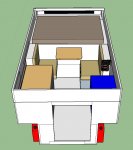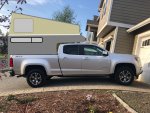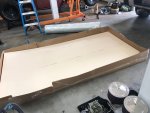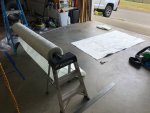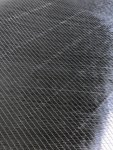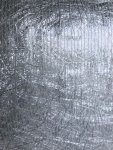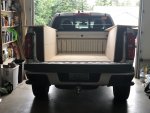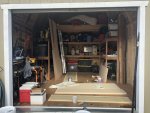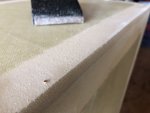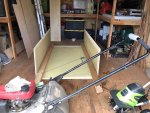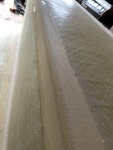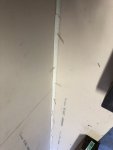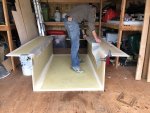Yes, 1/2" is plenty strong, especially once everything starts taking a 3d shape instead of flat panels. At one point, we had a piece of foam with glass laid up on both sides that was about 4" wide and 18" long; my husband (~190 lbs) supported the ends of the piece and then stood on the middle of it without it breaking. It deflected maybe 2", but didn't buckle. We did the same with XPS (only thicker and 6" wide) and the test piece buckled.
XPS has 2 issues. The primary failure method is that the foam compresses under the load and essentially allows the test panel to be folded in half, unfortunately I don't have a good picture of this. The 2nd issue it has is that the foam is so weak that the fiberglass skin will pull away from the foam taking a thin layer of foam with it. In the picture below, you can see that the fiberglass that has pulled away has a thin layer of the pink foam still bonded to it.
Thanks for posting all this info; really appreciate it!
Oddly I built nearly the identical sample with XPS using the same Foamular.
I had to jump up and "kung **** stomp" it to get it to break. The foam is indeed weak and very light (1.55 lb/ft^3 vs 5 lb for Divinycell) and will be the first thing to fail. I'd usually get a diagonal crack through the foam and then part of one side of the FG would break away from the foam.
But still I deemed it suitable for my use, which is a full size camper that is frame mounted. I believe it will survive the stresses it will encounter, and it's much less expensive. A look online shows
1in sheets of Divinycell are $324, plus I would have had to pay considerable shipping. Price with shipping would be ~$13/ft^2 vs $1/ft^2 for the 2" Foamular 250 I'm using. My full cost of materials for the epoxy, cloth and foam for the panels is <$6/ft^2. I couldn't justify using high priced foam.
I'm definitely not dissing your choices at all! I know... I tend to go the cheap route first and see if that works for me

Many people go for "the best" right off the bat and run with it.
The XPS foam does need to be properly prepped. Light sanding first and then clean the surface. I tried using a wallpaper perforator and carpet roller to texture the foam, but the thing that seems to work best is a
dog brush (recommend by someone on ExPo). It creates a lot of vertical slices.
I also have every sheet of foam edged with a piece of wood, for my piece of mind and to give the panel additional strength, particualrly at the corners and edges.




